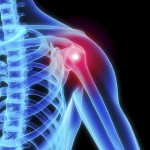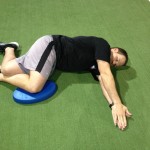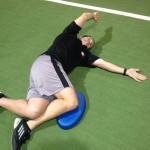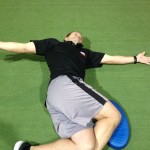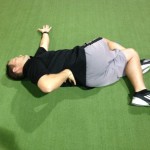Brian Schiff’s Blog
Injury Prevention, Sports Rehab & Performance Training Expert
As I write this update, I have now been back to work for a month. The first 3 days back were challenging, as I had not done that much with my arm in quite some time. I was sore by 5 pm each day, but no significant pain. The soreness resolved by the next morning. I quickly realized how weak I was as I attempted to stretch a client’s hamstring lifting the right leg up with my left arm.
With that said, going back to work also facilitated me moving the arm more frequently and using it against gravity. This has allowed me to regain more functional mobility and strength the past month. I have been careful to avoid any heavy or overhead lifting. I have not encountered something I could not do yet in patient care, but I have had to be aware of my body mechanics and positioning to reduce strain on the left arm.
MD follow-up
I saw the doctor this past Friday. He was pleased with my progress and encouraged me to keep working on regaining the last portion of my ROM. I will go back for one final appointment in 6 weeks. Of note, I had previously asked him to image the right shoulder to see if I had a tear since I have been having some right shoulder pain that has worsened since the left shoulder surgery. The MRI revealed a partial tear (30-40% of mostly bursal-sided fibers), some degeneration in the anterior labrum, biceps inflammation and a sizable bone spur. In essence, the doctor says I need to have the bone spur taken out in the near future to avoid a full tear on my right side. Not great news, but I am relieved it was not fully torn.
Rehab and Exercise
I am continuing to get stretched 2x/week, while doing my pulley and ROM exercises daily at home. I am performing scapular and rotator cuff strengthening about 3x/week. I returned to the gym for the first time on Labor Day. This was a humbling day to be sure as I cannot even do 50% of my previous weight with pull downs, rows and other lifts. But, Rome was not built in a day, and I know it will likely take up to a year to get back to 100% again.
Do you suffer with shoulder instability, shoulder weakness, poor trunk control or chronic shoulder/back pain? One of the biggest issues overhead athletes have is poor proximal stability, often leading to scapular dyskinesia. In turn, undue strain and force can cause stress on the rotator cuff and/or labrum.
In addition, nagging back pain can also occur as a result of repetitive micro-trauma. Improving pillar stability can reduce stress with hyperextension and rotation that creates stress and injuries in the lumbar spine.
This exercise is a unique and challenging way to improve shoulder and torso stability. In some instances, the stress on the wrist can be difficult, and in these cases I suggest using a closed fist on the stationary arm or moving to the knees. It is particularly effective exercise for swimmers, gymnasts, overhead athletes, and anyone with a history of shoulder instability.
In the case of shoulder pain and dysfunction, the lower trapezius and serrates anterior are often implicated as part of the problem. Research has shown that these two muscles often fatigue and don’t contribute equally to the force couple between them and the upper trapezius that facilitates upward rotation of the scapula.
Building scapular stabilization and dynamic stability is a must for those doing repetitive overhead activities such as throwing, swimming, serving, or work-related tasks. It is a given that asymmetries will exist, so optimizing the strength of the rotator cuff and scapular stabilizers is paramount to prevent injury and recover from overuse syndromes.
To strengthen the lower trapezius, one of my ‘go to’ exercises is the lower trap raise. It can be done with just the weight of your arms or using light dumbbells. The link below includes the full description for the exercise, and I also embedded the video below.
http://fit-pro.com/article-4137-Lower-trap-raise.html
In the next column, I will include a serratus anterior exercise using a kettle bell as a follow-up to this post.
Many of my clients need to improve shoulder and pillar stability. Combating poor glenohumeral and scapular stability and insufficient trunk stability is a must to reduce injury risk, resolve shoulder and back pain and eliminate compensatory motion with exercise, sport and life.
The following two exercises are “go to” ones I utilize to do just this.
The links above are for two recent exercise columns I authored for PFP Magazine. These exercises include load bearing using the client’s bodyweight and include progressions and regressions.
The shoulder mobility screen in the FMS often reveals side-to-side asymmetries. It is more common to see hypermobility in female clientele, while their male counterparts exhibit more hypomobility. Overhead athletes tend to demonstrate excessive horizontal external rotation and a relative loss of internal rotation on the dominant side. This hypomobility can be detrimental to overhead athletes and increase risk for overuse injuries if it becomes excessive.
The following exercise is an effective way to improve shoulder mobility and optimize function. One important point is to focus on form and move very deliberately through the motion.
Execution: Begin lying on the floor face up. Bend the left knee up to 90 degrees and cross the right leg over top of the left interlocking them. Roll to the left side and pin a folded towel or pad between the right knee and the floor. Place the arms in 90 degrees of shoulder flexion with the right on top of the left in an outstretched position. Next, slowly sweep the right arm up overhead and around the body as you attempt to place the torso/back on the floor. The finish position for the right arm will be reaching the right hand and arm up behind the back.
Exhale as you perform the sweeping motion and hold the end position for 2 seconds. Reverse direction and return to the start position. Perform 5-10 repetitions on each side.
Application: Limited shoulder mobility is a common finding, especially among male clientele with tightness in the pecs, lats and posterior shoulder. Asymmetry with respect to mobility is common with greater difficulty found trying to reach the dominant arm up behind the back on the FMS shoulder mobility screen. This exercise will help improve thoracic spine motion and shoulder mobility. The focus should be on strict form and proper stabilization to avoid unwanted motion. Pinning the pad (or towel roll) to the floor will help ensure better stabilization.
If hypomibility is an issue and clients score a 1, foam rolling the pec minor/major, latissimus dorsi and the posterior rotator cuff musculature prior to performing the exercise will be helpful. Stability training can be added in later once the soft tissue mobility restrictions and movement pattern is improving.


